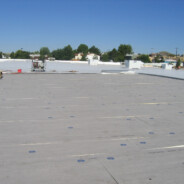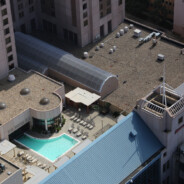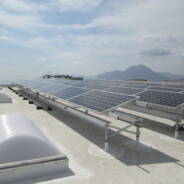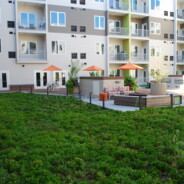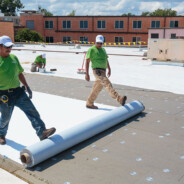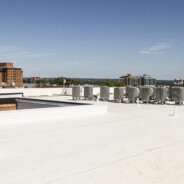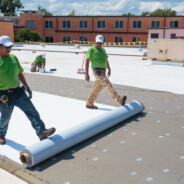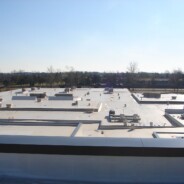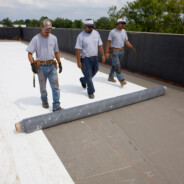Energy
October is Energy Action Month
In 2011 and each year thereafter, the former President of the United States proclaimed October to be National Energy Action Month. This designation was created to encourage energy-saving actions and to reduce national energy consumption. The presidential proclamations called upon citizens of the United States to recognize October as Energy Action Month by “working together to achieve greater energy security, a more robust economy, and a healthier environment for our children.” These are goals we think everyone can agree with. GenFlex’s Commitment Every year, commercial buildings represent nearly one-fifth of all U.S. energy consumption, according to the Department of Energy. Roofing is a critical component to any building,...
read moreRoofing Insulation Overview
If you want an energy-efficient roof, the first place to start is insulation. Proper insulation is one of the most important contributors to a building’s energy efficiency. Having a high R-value for your roof, the common measurement of thermal resistance, can also aid in achieving LEED® v4 and RoofPoint(TM) certifications. What’s Recommended The National Roofing Contractors Association (NRCA) recommends using two layers of insulation. This can be comprised of two layers of insulation boards or a single layer of insulation and a cover board. Always follow your local building codes when choosing the materials for a roof. Comparison of Three Types of Foam Insulation Type Advantages Caveats Polyisocyanurate...
read moreBallasted Roofs Are Cool!
You may not think that a roofing system developed almost fifty years ago could be environmentally friendly. While it’s true not many people were thinking green back then, it turns out ballasted roofs are indeed eco-friendly and worth a look. Ballasted roofs consist of thermal insulation boards (such as the GenFlex Polyiso product), EPDM single‑ply membrane (such as GenFlex FRM EPDM or AFR EPDM), and are topped with smooth, river‑washed stone or concrete pavers. They are easy and quick to install since they require no fasteners and no adhesives, which can be a source of Volatile Organic Compounds (VOCs). Ballasted roofs are also economical and long-lasting. The ballast material protects the membrane from harmful UV rays and...
read moreSolar Panel Installation Considerations
Solar panels are becoming more and more prevalent, and maybe you have been tasked with having some installed on your building. However, like with anything else, it is wise to do some research up front. While examining competing solar technologies to determine what will work best, also consider the impact of installing solar panels on your rooftop. There are four primary methods of attaching solar panels: Ballasted—Panels are held in place by weighted material and do not require roof penetration. This is a popular installation method. Penetrating—Panels are mounted on roof supports that penetrate the roof. These should be structurally attached and properly flashed. This method securely attaches the panel and provides good wind...
read moreGreen Roof Systems
A green roof is also referred to as a living roof or a vegetative roof. In simplest terms, it is a roof covered with living plant life. Green roof systems bring nature to the usually stark environment of a building’s rooftop. There are many reasons why more and more building owners are turning to green roof systems. Green roofs enhance the aesthetics of a building. If so designed, the roof can be a park-like area for the building tenants to enjoy as a retreat or perhaps a play area for children. Tenant community food gardens are also possible. Green roofs are great for the environment. They increase air quality since plants can absorb air pollutants and provide a nature habitat for wildlife including birds and butterflies....
read moreCool Roofs
Cool Roofs? No, it’s not a spinoff of MTV Cribs or a new series on HGTV! Rather, it is a term that refers to roofs that have both a high-solar reflectance (SR) and high-thermal emittance. If a roof has a high‑thermal emittance, it means that the roofing material does not retain a great deal of heat. A high SR means most of the sun’s rays are sufficiently reflected off the surface of the roof. Why is this important? The U.S. Department of Energy (DOE) states on their website that while a conventional roof can reach 150°F or more on a summer day, a “cool roof” can be more than 50°F cooler! Furthermore, the DOE reports that having a “cool roof” can translate into a 10 to 15% energy savings. So equipping a building with...
read moreGo Green to celebrate Earth Day
April 22 marks Earth Day and all through April, Earth month is celebrated as a time to be more conscious of the environmental footprint we leave in our daily lives. In the construction industry, the move towards “green” buildings is becoming increasingly popular, especially as we see agencies such as the Environmental Protection Agency (EPA) and the United States Green Building Council (USGBC) leading the way with new guidelines and training materials. For those of us in the roofing sector, we think of being “green” with the products we use and the practices we follow. Here are a few tips to help keep you “green” this month and through the rest of year: Use environmentally friendly products. This year, you...
read moreGenFlex EZ TPO Peel & Stick™ membrane makes for safe and speedy installation
When a member of the Broadmoor Church in Shreveport, Louisiana donated money to replace the 20-year-old roof, the project came to life in the summer of 2015. The church’s 17,500-square-foot building was prone to leaks and held two existing roofs, making it clear that it was time to replace the roof. Roofing contractor Steve Kinel, and his team from Corporate Roofing, led this project but worked closely with GenFlex distributor Bill Henderson, of Riverside Roofing Materials, and GenFlex sales representative, Chuck Steiner. The Broadmoor Church hosts many occupants on a regular basis, including a daycare, so it was extremely important that the roofing team find the right product to ensure a speedy and safe installation. After...
read moreEnergy-saving tips for Energy Action Month
The roof is often times your building’s first layer of protection against environmental elements, but it is also indispensable to your building’s overall energy efficiency. Energy consumption rates continue to climb, making it more important than ever to focus on ways to reduce a building’s energy needs. Selecting the best roofing materials for the project can greatly improve a building’s overall energy efficiency. While a cool roof membrane will work to keep a facility’s cooling cost lower during the summer, many parts of the country find great relief with a product more conducive to heat reflectivity. Read more about how GenFlex is doing its part to stay up-to-date with energy-efficiency standards in our recent post,...
read moreGenFlex practices Energy Action Month all year
President Obama declared October Energy Action Month as part of an overall federal agency initiative to reduce energy consumption. Every year, commercial buildings represent nearly one-fifth of all U.S. energy consumption, according to the Department of Energy. In the commercial sector, the top three end uses of energy consumption include space heating, lighting and space cooling. Combined, these three components represent approximately half of all commercial building energy consumption. To go along with this, commercial energy consumption grew between 58 percent and 69 percent from 1980 to 2009 and continues to rise. In more recent years, LEED® certification and the WELL Building Standard® are on the rise, and building...
read more
